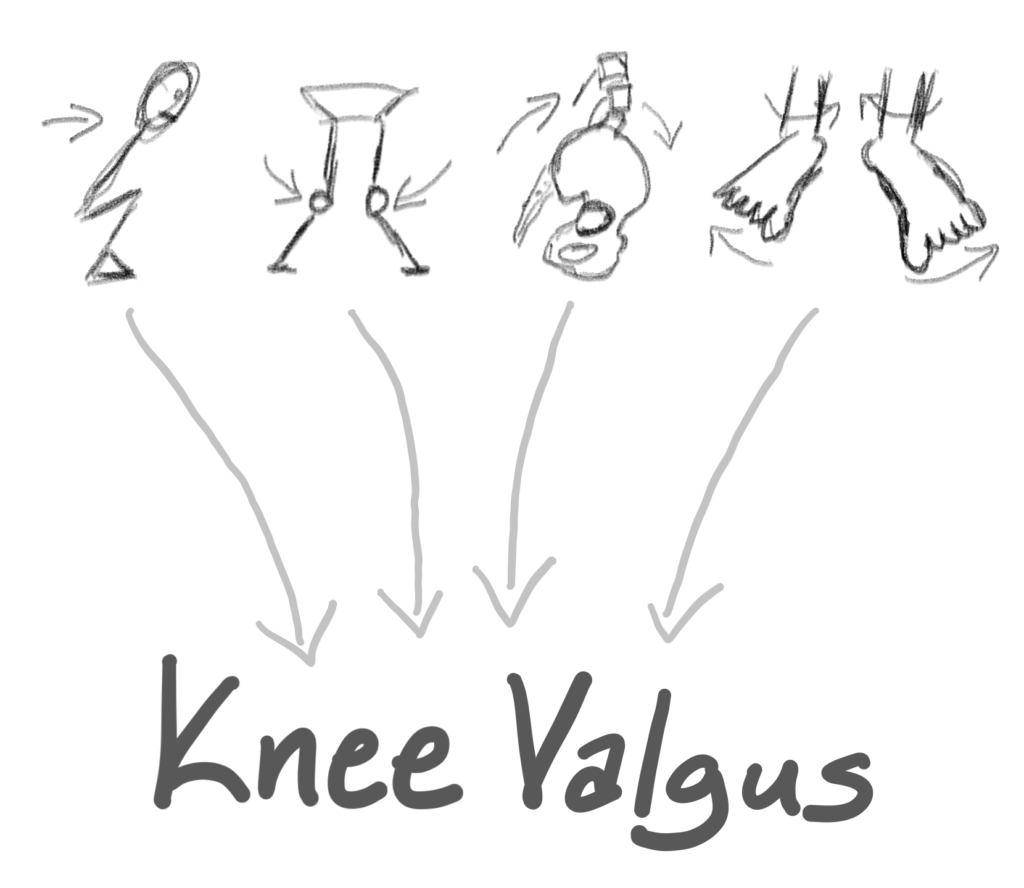Collapsing knees is the most common fault that I have to fix. Maybe tied with a forward shift… though sometimes they’re the same thing.
This collapse—knee valgus—actually reminds me of evolutionary biology.
Convergence
Ubiquitous problems like knee valgus deceive even experienced coaches. If you see something over and over and over again, it feels familiar. We conflate common with simple, try out a cue, then get frustrated when it doesn’t work.
Frequently seeing an issue doesn’t mean it’s easy to fix. But it can be easy if you have a flowchart in your head for fixing it.
One of the principles of evolution is the idea of “convergence”.

In biology, we have multiple species developing the same trait, such as wings.
In fitness, we have multiple movement dysfunctions materializing as the same motor pattern, such as knee valgus.
Have you ever seen knees caving, cued them out, and saw absolutely zero improvement? I know I have.
In this article, I’m going to give you a flow chart. We’ll build a detailed analysis of knee valgus so that you can still fix it when the “knees out” cue isn’t enough.
Identify the Issue
What is it? What is the dysfunctional movement?
Knee valgus is when the knees fall inside the line made by the hip and foot.
How do you know it’s a problem?
For force to be transferred through bone and muscle, the joints should be stacked on one another. When the knee is inside the hip and foot, there’s excessive stress on the lateral knee, ACL, MCL, and meniscus.
This excessive stress is an issue because these structures are considered “passive” meaning they are not able to provide contractile strength. They can also be stretched so much that they become less useful.
The poor knee alignment is an issue because long-term strength gains are sacrificed, because it limits movement options in the following activity (i.e. sports), and because strength gained in this position is not as “functional” for daily living.
The excessive stress on passive tissues is an issue because resulting knee instability is irreversible and the tissues can be irreversibly damaged.
Damage to passive tissues is an issue because it may require surgery, which has risks.
Surgery is an issue because it is expensive, both in time and money.
Or maybe the answer is simply: I’m looking at it… and it just doesn’t look right.
What are the joint positions or motions within, above, and below?
- Within: the femur is internally rotating.
- Above: the pelvis is anteriorly tilting.
- Below: the foot is pronating.
What could be driving it? Why is it present?
- Weight is too heavy
- Athlete is too fatigued
- Body shifts forward
- Lack of strength
- Lack of motor control
- Knees fall inward
- Lack of strength
- Lack of motor control
- Lumbar spine and pelvic position
- The hip joint position may be directing the knees inward and bodyweight forward.
- Foot and ankle
- Tibial external torsion or rotation
- High arches promote varus leading to valgus (see below)
- Structurally flat feet without orthotic support
- Functionally flat feet lacking strength and motor control
- Varus leading to valgus
- Motor control, knees TOO far out
- High foot arches
How will you fix it?
First, try cues to fix the position
- “Keep your knees out”
- “Sit back”
- “Round your low back a little”
If this works, the exercise may fix the dysfunction. Keep using it and be diligent about technique.
If this doesn’t FULLY fix the problem, look elsewhere:
- If their feet are messed up, help them get the support they need.
- If they can’t fix their position, put them in another position that will help them feel where they need to be, i.e. corrective exercise.
- If the weight is too heavy, slow down, lower it the weight, or do fewer reps.
- If the athlete is too fatigued, tell them to keep it together or increase rest.

Fixing Knee Collapse in a Squat
Here’s a simple overview of how I might go about fixing knee valgus.
Fixing Knee Collapse in a Deadlift
Here’s a more detailed approach to fixing knee valgus.
Fixing Forward Shift in a Squat
If poor balance is the issue, you can cue the athlete to “sit back at the bottom” of the squat or you can put a weight in front of the body, forcing them to sit back without thinking.
Spine Position
The axial skeleton is the centerpiece of the body. Dysfunction here likely means dysfunction elsewhere. I use four points to fix the spine position:
- Feet flat
- Set hips
- Ribs down
- Look forward
Fixing Wide Knees in a Squat
As mentioned above, sometimes the knees collapse to actually IMPROVE alignment. I see this a lot in a lifter who has overutilized the “knees out” cue.
Asymmetrical Problems
Though this isn’t what we usually think about when we picture a knee collapse, often time the valgus is worse on one side than the other. Asymmetrical problems usually need asymmetrical fixes.
Shifting During Squats
Here we discuss how I think about this shift and we do an exercise I like to use to help people out. Push evenly between both feet and don’t forget the inner thigh, outer hip, and outer ab muscles.
Shifting During Deadlifts
Here’s another context we might notice asymmetrical knee collapse.
Final Thoughts
Most of the time the problem isn’t that complicated. Look at yourself and try fixing whatever looks wrong.
When things ARE complicated, though, you need to run through the possibilities until you find improvement. It’s not always as simple as “knees out”.
This whole process is about finding a position that you can maintain for long-term training.
The Movement Seminar
I started The Movement Seminar because I had people asking me for it. They’ve learned various functional exercise and movement systems (usually abbreviated in acronyms), but they don’t know how to apply them to their own life.
Most people understand that movement is important, but nobody wants to be stuck getting called a “functional trainer”.
The Movement Seminar is here to help you find the answers you need. It makes you the expert in your community. Trainers leave will leave their clients feeling blown away, rather than simply meeting the sickeningly low expectations set by the fitness industry.
Just ask Alex, one of the initial attendees, who’d been unsuccessfully working on his pistol squat for years. After two weeks, he fixed his problem.
What problems do you have to fix?
How are you going to fix them?
Do you want help?